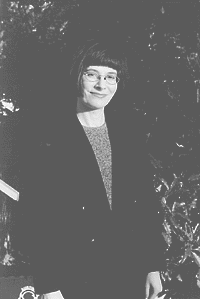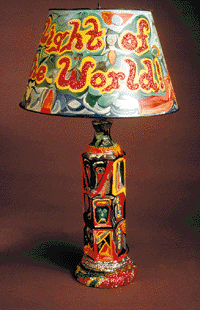Untrained Wonders
UT's Exhibition of Self-Taught Artists Features Miracles
By Rebecca S. Cohen, Fri., Sept. 12, 1997
|
|
|
|
While she has yet to put together the ultimate bloody hog show, Adele has had significant experience in studying the work of untrained artists, which is why this assistant curator of education was tapped by Huntington Gallery Director Jessie Otto Hite to curate a major exhibition. In 1989, Adele organized an exhibition called "Black History/Black Vision" for the gallery and prepared the corresponding catalogue, published by UT Press. According to Hite, "She is a leading authority on self-taught artists and has lectured and published nationally on this topic." The stout catalogue accompanying "Spirited Journeys" profiles the artists represented in the exhibition and includes color photographs of each of the works in the show as well as representative images from the folk art environments (The Orange Show and Beer Can House in Houston, to name two) represented in the exhibition by slides. The only tiny tear in this otherwise seamless project was the upside-down insertion of one of Ezekiel Gibb's last drawings in the catalogue. Ironically -- or appropriately? -- that particular work belongs to this arts writer and her husband, who are delighted, in any event, to have it included in the exhibition. A total of 150 works in all were selected, many that surprised and delighted even the most experienced outsider art aficionados. Learning the stories behind their stories made looking at the work even more fun.
God appeared to Felix "Fox" Harris of Beaumont, Texas in a vision and told him to quit drinking. "Then he told Fox that he would receive the gift of new life, and held out [a] piece of white paper as a sign." And so Fox Harris began to collect discarded objects so that he could emulate God. "Using the humblest of materials, he created objects of extraordinary beauty," huge totems, 10 to 15 feet high, that soon covered his property. The old man, himself over six feet tall, climbed up on wooden stilts so that he could see his sculptures better when they were finished and to add little touches once they'd been raised up toward the sky. Photographer Keith Carter and his wife Pat, both from Beaumont where Harris lived, befriended the artist, recorded what he had to say about his work, took his picture. By climbing to the upstairs gallery, visitors can get some idea of what the artist saw when he looked at his work from a viewing platform he made for himself in a tree. But at the Huntington, the totems are best observed from the ground floor, wonderfully grouped against a backdrop of delicious C.A.A. Dellschau drawings, their wiggly, whirligig topknots soaring toward the black-painted wall on the second floor. After Harris' death in 1985, 120 of his sculptures were given to the Art Museum of the Southeast in Beaumont, which no longer displays them because of their vulnerability to wind and weather and decay. Since 1995, they've remained in storage, making the presence of five spectacular examples in Austin that much more precious.
The fingers on Vanzant Driver's right hand were crushed by 600 pounds of steel nine days after his divorce in 1982. Rather than give himself up to despair, Driver prayed for recovery against long odds. He regained use of his hand. The experience proved to him "the importance of having a relationship with God." Later, when he was laid off his construction job, he decided to expand production of the little glass sculptures he'd been making for his own enjoyment. Driver's two glass churches in the exhibition astonish with their organic forms made of stiff shimmering shards of glass. It's worth crouching low to look inside both of them, to see the interior crosses in front of mirrored glass, the ceiling details. No wonder that his first collectors included artists, dealers, and museum professionals who bought his sculptures from Houston's Contemporary Arts Museum gift shop where he'd been inspired to take them (although he'd never been inside a museum before). In 1991, Driver disappeared from the Texas art scene with the State of Texas Attorney General's office in hot pursuit, apparently for failure to pay child support.
|
|
Peter Paul Drgac didn't begin making art until he was 85 years old. Born in a Czech farming community in Burleson County in 1883, he raised a family, ran a grocery store, even baked bread and made some of his wife's clothes. After his wife died in 1962, he took refuge in gardening until he decided to paint a flower box he'd built. And then he began decorating every available surface in his house. Finally, he painted his designs on paper with enamel paint. In the remaining eight years of his life, Drgac created several hundred drawings whose simple forms are reminiscent of Pennsylvania Dutch art: simply designed animals and plants and domestic images, rendered in pleasant colors. According to Adele, "Drgac's paintings appear to be visual inventories, perhaps inspired by his many years of arranging objects in rows on grocery store display shelves."
Born in 1958, Ike Morgan is the youngest living artist represented in the exhibition. He stood near his case worker throughout the opening festivities. Morgan has lived at the Austin State Hospital since 1977, when he was determined incompetent to stand trial for the murder of his grandmother. He has been diagnosed with schizophrenia. How did he handle the transition, I wondered, from his normally sequestered and structured daily environment to the rip-roaring good cheer of an art opening at the Huntington Gallery, men shaking his hand, women praising his disturbing presidential portraits and a lopsided Last Supper? His Four Part Lincoln, drawn on four separate pieces of paper that have been mounted together, is a particularly striking example of the artist's abilities and, perhaps, his emotional disability. At the opening, Morgan wore a plain brown suit and, I thought, an ironic, occasionally joyful expression. Someone reminded me that schizophrenics are not capable of irony. I am not so sure. In any event, what a pity if he couldn't enjoy the company of Chuck and Jan Rosenak, who wrote the Museum of American Folk Art Encyclopedia of Twentieth-Century American Folk Art and Artists and Contemporary American Folk Art: A Collector's Guide, which grace the shelves of every serious collector of self-taught artists' work. The Folk Art Encyclopedia quotes Morgan as saying, "The art keeps the voices to the back of my head. I need water, food, and art." The Rosenaks came all the way from New Mexico to see the exhibition. Bruce and Julie Webb of Webb Gallery came in from Waxahachie. Webb Gallery and Austin's Yard Dog Gallery exhibit work by Morgan and a significant number of the other artists represented in the exhibition. They seemed pleased to watch as autograph seekers approached Ike Morgan, proffering pens and open copies of the "Spirited Journeys" catalogue. Adele says that he enjoyed answering questions about his work, especially those posed by young women. I wondered if he didn't find the attention disconcerting.
I suppose I should have asked, but I was overwhelmed myself as I watched Morgan, Spelce, and fellow honorees Hector Alonzo Benavides, Mark Cole Greene, and David Strickland warily eyeing the enthusiastic crowd that had come to see their paintings and sculpture. This is work for trained artists, I thought, for graduates of art colleges and universities who put themselves to sleep at night with dreams of becoming artists rather than of making art and telling stories. The trained artist's obsession, it seems, is about being recognized by critics and peers, about making a mark in art history tomes. For them, the simple act of making marks sometimes takes a back seat. According to Lynne Adele:
Self-taught artists stand apart from their academically trained counterparts most notably in their original intent, which is generally not, at least initially or consciously, to make `art' for a perceived audience.... The artists selected for this exhibition are individuals whose work represents a unique vision and style developed on their own, uninfluenced by other artists, trends, or formal art traditions.
"I've painted just about everything I ever did or ever saw," said Ezekiel Gibbs. "Sometimes, when I think I'm just about played out, I sit down and rest awhile. Then I just go to it again. You just have to keep on doing whatever you're doing." Some of Gibbs' family members thought the effort was too hard on him and took away his drawing paper toward the end, so Ezekiel Gibbs made his last marks on the wall of his room, just before he died at the age of 103.
"Spirited Journeys: Self-Taught Texas Artists of the Twentieth Century" is on view at the Archer M. Huntington Art Gallery in the Art Building, UT campus, through October 19. Call 471-7023.
Rebecca S. Cohen is an arts writer and recovering art dealer.











